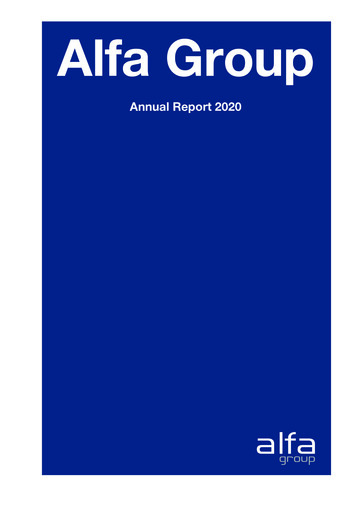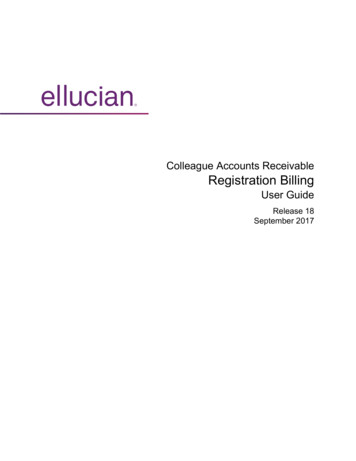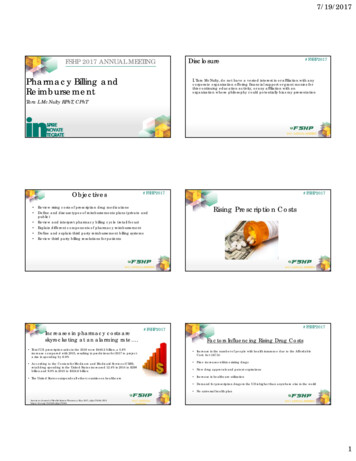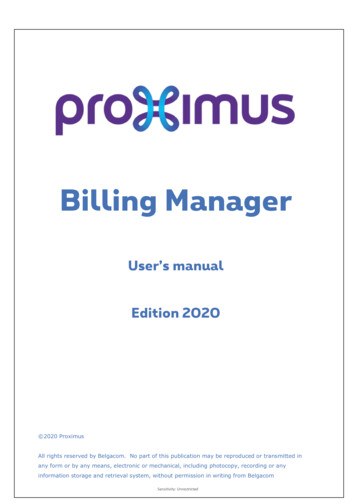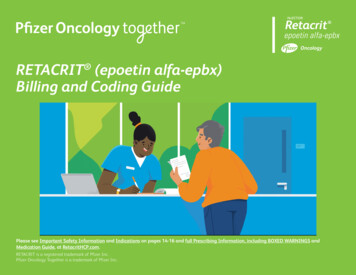
Transcription
RETACRIT (epoetin alfa-epbx)Billing and Coding GuidePlease see Important Safety Information and Indications on pages 14-16 and full Prescribing Information, including BOXED WARNINGS andMedication Guide, at RetacritHCP.com.RETACRIT is a registered trademark of Pfizer Inc.Pfizer Oncology Together is a trademark of Pfizer Inc.
IntroductionPfizer Inc. has developed this reference guide to assist healthcare providers (HCPs) with understanding coding for RETACRIT (epoetin alfa-epbx), an epoetinalfa biosimilar approved for use in the United States, for intravenous or subcutaneous use.The information provided in this document is intended for informational purposes only and is not a comprehensive description of potentialcoding requirements for RETACRIT. Coding and coverage policies change periodically and often without notice. The HCP is solely responsible fordetermining coverage and reimbursement parameters and appropriate coding for treatment of his/her patients. The information provided shouldnot be considered a guarantee of coverage or reimbursement for RETACRIT.Please see Important Safety Information and Indications on pages 14-16 and full Prescribing Information, including BOXED WARNINGS andMedication Guide, at RetacritHCP.com.2
Making your patients’ support needs a priority. Together.At Pfizer Oncology Together, patient support is at the core of everything we do. We’ve gathered resources and developed tools to help patients and their lovedones throughout RETACRIT treatment. From helping to identify financial assistance options to connecting patients to resources for emotional support, yourpatients’ needs are our priority.*Benefits VerificationWe can help determine a patient’s coverage and out-of-pocket costs.Prior Authorization (PA) AssistanceWe can coordinate with a patient’s insurer to determine the PA requirements. After a PA request issubmitted, we can follow up with the payer until a final outcome is determined.Appeals AssistanceWe can review the reasons for a denied claim and provide information on payer requirements. After anappeal is submitted, we can follow up with the payer until a final outcome is determined.Billing and Coding Assistance for Injectable ProductsFor your patient claim submissions, we provide easy access to sample forms and template letters, alongwith billing and coding information for physician office and hospital outpatient settings of care.Patient Financial AssistanceWe can help patients understand their benefits and connect them with financial assistance resources.FOR LIVE, PERSONALIZED SUPPORTCall 1-877-744-5675 (Monday–Friday 8 AM–8 PM ET)VISITPfizerOncologyTogether.com*Some services are provided through third-party organizations that operate independently and are not controlled by Pfizer. Availability of services and eligibility requirements are determinedsolely by these organizations.Please see Important Safety Information and Indications on pages 14-16 and full Prescribing Information, including BOXED WARNINGS andMedication Guide, at RetacritHCP.com.3
Coding OverviewIn the physician office, hospital outpatient department, and dialysis sites of care, Medicare Administrative Contractors (MACs), private commercial payers,and Medicaid may recognize the following codes for reporting RETACRIT on claim forms. RETACRIT will be covered under the End-Stage Renal Disease (ESRD)Prospective Payment System for utilization in the dialysis setting.Coding for RETACRITThe Centers for Medicare & Medicaid Services (CMS) assigned RETACRIT product-specific Healthcare Common Procedure Coding System (HCPCS) codes toidentify ESRD and non-ESRD utilization of RETACRIT. The HCPCS code used to report RETACRIT is different for ESRD and non-ESRD use. HCPs may use thefollowing HCPCS codes for all payers in all settings of care.1HCPCS Code1DescriptorQ5105Injection, epoetin alfa-epbx, biosimilar, (Retacrit) (for ESRD on dialysis), 100 unitsQ5106Injection, epoetin alfa-epbx, biosimilar, (Retacrit) (for non-ESRD use), 1,000 unitsModifiers may be included on ESRD and non-ESRD claims to provide additional information. The JW modifier is used to report the amount of the drug that isunused after administration to a patient. For Medicare and some payers, the unused amount should be reported on a separate line of the claim form, and theclaim should include the drug code, modifier, and number of units discarded.2 When reporting the administration of erythropoiesis-stimulating agents (ESAs)on non-ESRD claims, Medicare and some payers may require modifier EA, EB, or EC to specify anemia.3 Modifier ED or EE and GS may be used to describehematocrit levels.4 For ESRD claims, some payers may require modifier JA or JB to be reported, indicating the route of administration.5 Additional modifiersmay also be considered appropriate when submitting claims.HCPCS Modifier1JWEAEBECEDEEEJGSJAJBDescriptorDrug amount discarded/not administered to any patientESA administered to treat anemia due to chemotherapyESA administered to treat anemia due to radiotherapyESA administered to treat anemia not due to radiotherapy or chemotherapyHematocrit level has exceeded 39% (or hemoglobin level has exceeded 13.0 g/dL) for 3 or more consecutive billing cycles immediately prior toand including the current cycleHematocrit level has not exceeded 39% (or hemoglobin level has not exceeded 13.0 g/dL) for 3 or more consecutive billing cyclesimmediately prior to and including the current cycleSubsequent claims for a defined course of therapy, e.g., EPO, sodium hyaluronate, infliximabDosage of erythropoietin stimulating agent has been reduced and maintained in response to hematocrit or hemoglobin levelAdministered intravenouslyAdministered subcutaneouslyPlease see Important Safety Information and Indications on pages 14-16 and full Prescribing Information, including BOXED WARNINGS andMedication Guide, at RetacritHCP.com.4
RETACRIT National Drug Codes for PfizerNational Drug Codes (NDCs) are unique 10-digit, 3-segment numbers used to identify drugs.6Strength7Vial Size10-Digit NDC2,000 Units/mL3,000 Units/mL4,000 Units/mL10,000 Units/mL40,000 Units/mL20,000 Units/mL20,000 Units/2 mL1 mL single-dose vial1 mL single-dose vial1 mL single-dose vial1 mL single-dose vial1 mL single-dose vial1 mL multiple-dose vial2 mL multiple-dose 010069-1309-010069-1311-010069-1318-01NDC Conversion ExampleFor reimbursement purposes, some payers may require the HCP to include NDCs on the claim form. For claims-reporting purposes, some payers may alsorequire HCPs to convert the 10-digit NDC to an 11-digit NDC by adding a “0” (zero), where appropriate, to create a 5-4-2 configuration. The zero is added infront of the first segment of numbers when the 10-digit format is the 4-4-2 configuration. See placement of the red zero in the example below.StrengthVial Size10-Digit NDC11-Digit NDC2,000 Units/mL1 mL single-dose vial0069-1305-0100069-1305-01Please see Important Safety Information and Indications on pages 14-16 and full Prescribing Information, including BOXED WARNINGS andMedication Guide, at RetacritHCP.com.5
Coding for RETACRIT Administration ServicesCurrent Procedural Terminology (CPT ) codes define specific medical procedures performed by physicians.8The following codes may be used to report the administration of RETACRIT:Type of CodeCode/DescriptorRelevant Sites of Service96372: Therapeutic, prophylactic, or diagnostic injection (specify substance or drug);subcutaneous or intramuscularAdministration:CPT codes896374: Therapeutic, prophylactic, or diagnostic injection (specify substance or drug);intravenous (IV) push, single or initial substance/drugPhysician office, hospital outpatientdepartment, dialysis facility96375: Therapeutic, prophylactic, or diagnostic injection (specify substance or drug);each additional sequential IV push of a new substance/drug (list separately in additionto code for primary procedure)Hospital outpatient departments and dialysis facilities use revenue codes to report specific accommodations and/or ancillary charges.9Type of CodeCode/Descriptor0634: Drugs requiring specific identification – EPO under 10,000 units0635: Drugs requiring specific identification – EPO 10,000 units or moreRevenue codes10Relevant Sites of ServiceHospital outpatient department,dialysis facility0636: Drugs requiring specific identification – detailed coding0500: Outpatient services – general classificationHospital outpatient department0510: Clinic – general classificationKey: EPO – erythropoietin.Current Procedural Terminology (CPT ) is a registered trademark of the American Medical Association.Please see Important Safety Information and Indications on pages 14-16 and full Prescribing Information, including BOXED WARNINGS andMedication Guide, at RetacritHCP.com.6
Diagnosis Coding for RETACRITRETACRIT (epoetin alfa-epbx) is an FDA-approved biosimilar.The International Classification of Diseases, 10th Revision, Clinical Modification (ICD-10-CM) code set should be used, as appropriate, to report the patientspecific diagnosis.RETACRIT is typically reported using a primary diagnosis code for anemia and a secondary diagnosis code for a disease indication. Payer-specific codingrequirements should be verified by the HCP, including the order (eg, primary, secondary, etc) of required codes. HCPs should verify payer-specific codingrequirements before submitting a claim, as these may vary by payer.Coding to Report Anemia and Related ConditionsICD-10-CM codes to report anemia and related conditions may include, but are not limited to, the following codes:ICD-10-CM Code11B20D63.1*D64.81Code DescriptorHuman immunodeficiency virus disease (Code first human immunodeficiency virus [HIV] disease complicatingpregnancy, childbirth, and the puerperium, if applicable [O98.7-]. Use additional code[s] to identify allmanifestations of HIV infection)Anemia in chronic kidney disease (Code first underlying chronic kidney disease [N18.-])N18.30Anemia due to antineoplastic chemotherapyHypertensive chronic kidney disease with stage 5 chronic kidney disease or end-stage renal disease (Use additional codeto identify the stage of chronic kidney disease [N18.5, N18.6])Chronic kidney disease, stage 3 unspecifiedN18.31Chronic kidney disease, stage 3aN18.32Chronic kidney disease, stage 3bN18.4Chronic kidney disease, stage 4 (severe)N18.5Chronic kidney disease, stage 5Asymptomatic human immunodeficiency virus infection status (Code first human immunodeficiency virus diseasecomplicating pregnancy, childbirth, and the puerperium, if applicable [O98.7-])I12.0Z21*Only to be billed by a nephrologist.12Please see Important Safety Information and Indications on pages 14-16 and full Prescribing Information, including BOXED WARNINGS andMedication Guide, at RetacritHCP.com.7
RETACRIT Billing UnitsESRDThe RETACRIT HCPCS code Q5105 is described as “Injection, epoetin alfa-epbx, biosimilar, (Retacrit) (for ESRD on dialysis), 100 units.” Each dose increment of100 Units equals 1 billing unit. For example, a 2,000 Units/mL vial of RETACRIT represents 20 billing units of Q5105. See the chart below correlating a vial ofRETACRIT administered with the number of billing units based on the description of Q5105.StrengthVial SizeNumber of Q5105 Billing Units (100 Units epoetin alfa-epbx biosimilar per 1 billing unit)Equivalent to the Units of RETACRIT in Each Vial2,000 Units/mL1 mL single-dose vial3,000 Units/mL1 mL single-dose vial4,000 Units/mL1 mL single-dose vial10,000 Units/mL1 mL single-dose vial40,000 Units/mL1 mL single-dose vial20,000 Units/mL1 mL multiple-dose vial20,000 Units/2 mL2 mL multiple-dose vial20 units30 units40 units100 units400 units200 units200 unitsNon-ESRDThe RETACRIT HCPCS code Q5106 is described as “Injection, epoetin alfa-epbx, biosimilar, (Retacrit) (for non-ESRD on dialysis) 1,000 units.” Each doseincrement of 1,000 Units equals 1 billing unit. For example, a 2,000 Units/mL vial of RETACRIT represents 2 billing units of Q5106. See the chart belowcorrelating a vial of RETACRIT administered with the number of billing units based on the description of Q5106.StrengthVial SizeNumber of Q5106 Billing Units (1,000 Units epoetin alfa-epbx biosimilar per 1 billing unit)Equivalent to the Units of RETACRIT in Each Vial2,000 Units/mL1 mL single-dose vial3,000 Units/mL1 mL single-dose vial4,000 Units/mL1 mL single-dose vial10,000 Units/mL1 mL single-dose vial40,000 Units/mL1 mL single-dose vial20,000 Units/mL1 mL multiple-dose vial20,000 Units/2 mL2 mL multiple-dose vial2 units3 units4 units10 units40 units20 units20 unitsPlease see Important Safety Information and Indications on pages 14-16 and full Prescribing Information, including BOXED WARNINGS andMedication Guide, at RetacritHCP.com.8
Claims Submission ChecklistThe following may be considered to assist with submitting claims completely and accurately, which is important for timely claims processing, for appropriatepayment, and to avoid denied claims.Provide the patient name, address, and insuranceidentification number, and review these for accuracyInclude the HCP’s name, National Provider Identifier (NPI),and payer-specific provider ID (if applicable)Indicate the appropriate place of service code (2-digit code)for where the treatment was providedCheck to ensure that ICD-10-CM diagnosis codes, CPTprocedure codes, and modifiers (if applicable) are consistentwith information included in the patient’s medical recordReview the RETACRIT-specific information (eg, nameof drug, HCPCS code, NDC, number of units, route andfrequency of administration)Please see Important Safety Information and Indications on pages 14-16 and full Prescribing Information, including BOXED WARNINGS andMedication Guide, at RetacritHCP.com.9
Sample Claim Form: CMS-1500, Physician Office Setting (Non-ESRD)ELPSAMItem 21: Specify the appropriateICD-10-CM diagnosis code(s)This sample form is intended as a reference for the coding and billingof RETACRIT. This form is not intended to be directive and the useof the recommended codes does not guarantee reimbursement.HCPs may deem other codes or policies more appropriate and shouldselect the coding options that most accurately reflect their internalguidelines, payer requirements, practice patients, and servicesrendered.Item 19: If additionalinformation is required todescribe RETACRIT (eg, NDC),this information may becaptured in Item 19XXX.XXXXMM DDYYMMDDYY11Q5106A2MM DDYYMMDDYY1196xxxA1Item 24D: Specify the appropriateHCPCS and CPT codes and modifiers;for example: Drug: Q5106 for RETACRIT Administration: 96xxx foradministrationPLEASE PRINT OR TYPEAPPROVED OMB-0938-1197 FORM 1500 (02-12)Item 24G: Specify the billingunits. For example, 1 billing unit 1,000 Units of epoetin alfa-epbxbiosimilar (RETACRIT) for HCPCScode Q5106. To bill 2,000 Unitsof RETACRIT, enter 2 billingunits. To bill 1 96xxx for drugadministration, enter 1 billingunitItem 24E: Enter reference to thediagnosis for the CPT and HCPCScodes from Item 21Please see Important Safety Information and Indications on pages 14-16 and full Prescribing Information, including BOXED WARNINGS andMedication Guide, at RetacritHCP.com.10
Sample Claim Form: UB-04, Hospital Outpatient Setting (Non-ESRD)This sample form is intended as a reference for the coding and billing ofRETACRIT. This form is not intended to be directive and the use of therecommended codes does not guarantee reimbursement. HCPs maydeem other codes or policies more appropriate and should select thecoding options that most accurately reflect their internal guidelines,payer requirements, practice patients, and services rendered.Form Locator (FL) 44: Specify the appropriateHCPCS and CPT codes and modifiers; for example: Drug: Q5106 for RETACRIT Administration: 96xxx for drug administration06360510ELPSAMDrugs requiring specific identification – detailedcoding (for RETACRIT)Q5106MM DD YY2Clinic – general classification (for IV injection administered inhospital-based dialysis clinics)96xxxMM DD YY1FL 39-41: Enter value code 48 with hemoglobin level reading orvalue code 49 with hematocrit level readingFL 46: Specify the billing units. For example, 1 billing unit 1,000 Units of epoetin alfa-epbxbiosimilar (RETACRIT) for HCPCS code Q5106. To bill 2,000 Units of RETACRIT, enter 2billing units. To bill 1 96xxx for drug administration, enter 1 billing unitFL 42 and 43: Specify revenue codes and describe procedure; for example: 0636: Drugs requiring specific identification – detailed coding (for RETACRIT) 0510: Clinic – general classification (for IV injection administered in hospital-baseddialysis clinics)Note: Other revenue codes may applyFL 67: Specify the appropriateICD-10-CM diagnosis code(s)xxx.xxxxPlease see Important Safety Information and Indications on pages 14-16 and full Prescribing Information, including BOXED WARNINGS andMedication Guide, at RetacritHCP.com.11
Sample Claim Form: UB-04, Dialysis Provider for Use in Dialysis (ESRD)This sample form is intended as a reference for the coding andbilling of RETACRIT. This form is not intended to be directiveand the use of the recommended codes does not guaranteereimbursement. HCPs may deem other codes or policies moreappropriate and should select the coding options that mostaccurately reflect their internal guidelines, payer requirements,practice patients, and services rendered.FL 44: Specify the appropriate HCPCS and CPTcodes and modifiers; for example: Drug: Q5105 for RETACRIT Administration: 96xxx for drug administration063x0510ELPSAMDrugs requiring specific identification – EPOXXXXX units (for RETACRIT)Q5105MM DD YY20Clinic – general classification (for IV injection administered inhospital-based dialysis clinics)96xxxMM DD YY1FL 39-41: Enter value code 48 with hemoglobin level reading orvalue code 49 with hematocrit level readingFL 46: Specify the billing units. For example, 1 billing unit 100 Units of epoetin alfa-epbxbiosimilar (RETACRIT) for HCPCS code Q5105. To bill 2,000 Units of RETACRIT, enter 20billing units. To bill 1 96xxx for drug administration, enter 1 billing unitFL 42 and 43: Specify revenue codes and describe procedures, for example: 0634: Drugs requiring specific identification – EPO under 10,000 units (for RETACRIT), or 0635: Drugs requiring specific identification – EPO 10,000 units or more (for RETACRIT) 0510: Clinic – general classification (for IV injection administered in hospital-based dialysis clinics)Note: Other revenue codes may applyFL 67: Specify the appropriateICD-10-CM diagnosis code(s)xxx.xxxxPlease see Important Safety Information and Indications on pages 14-16 and full Prescribing Information, including BOXED WARNINGS andMedication Guide, at RetacritHCP.com.12
References1.Centers for Medicare & Medicaid Services (CMS). 2020 Alpha numeric HCPCS file. c-HCPCS-File.Accessed April 7, 2020.2.Centers for Medicare & Medicaid Services (CMS). Medicare program JW modifier: drug/biological amount discarded/not administered to any patient frequently asked questions. August 26, W-Modifier-FAQs.pdf. Accessed April 3, 2020.3.Centers for Medicare & Medicaid Services (CMS). Pub 100-04 Medicare claims processing: reporting of hematocrit or hemoglobin levels on all claims for the administration of erythropoiesis stimulating agents (ESAs),implementation of new modifiers for non-ESRD indications, and reporting of hematocrit/hemoglobin levels on all non-ESRD, non-ESA claims requesting payment for anti-anemia drugs. January 11, Guidance/Transmittals/downloads/R1412CP.pdf. Accessed April 3, 2020.4.Centers for Medicare & Medicaid Services (CMS). MLN Matters Number: MM5700: modification to the national monitoring policy for erythropoiesis stimulating agents (ESAs) for end-stage renal disease (ESRD) patientstreated in renal dialysis facilities. Implemented January 7, 2008. s/MM5700.pdf. Accessed April 3, 2020.5.Centers for Medicare & Medicaid Services (CMS). Medicare Learning Network (MLN) Matters. Implementation of the Medicare Improvements for Patients and Providers Act of 2008 (MIPPA) 153c End StageRenal Disease (ESRD) Quality Incentive Program (QIP) and other requirements for ESRD claims. Implemented January 3, 2012. s/MM7460.pdf. Accessed April 3, 2020.6.U.S. Food and Drug Administration (FDA). National Drug Code directory. 2438.htm. Content current as of November 18, 2019. Updated April 3, 2020.7.RETACRIT [package insert]. New York, NY: Pfizer Inc.; 2020.8.American Medical Association. 2020 CPT Professional Edition. Current Procedural Terminology (CPT ) is copyright 2019 by the American Medical Association. All rights reserved. Chicago, IL: AMA; 2019.9.Centers for Medicare & Medicaid Services (CMS). Transmittal 167. April 30, 2004. nce/Transmittals/downloads/R167CP.pdf. Accessed April 3, 2020.10. Research Data Assistance Center (ResDAC). Revenue Center Code. Revenue%20Center%20Table.txt. Accessed April 3, 2020.11. Centers for Medicare & Medicaid Services (CMS). 2021 ICD-10-CM Tabular list of disease and injuries. . Last modified August 19, 2020. Accessed October 28, 2020.12. Centers for Medicare & Medicaid Services (CMS). CMS Manual. SUBJECT: ICD-10 and other coding revisions to national coverage determinations (NCDs). November 9, Guidance/Transmittals/2017Downloads/R1975OTN.pdf. Accessed April 3, 2020.Please see Important Safety Information and Indications on pages 14-16 and full Prescribing Information, including BOXED WARNINGS andMedication Guide, at RetacritHCP.com.13
IMPORTANT SAFETY INFORMATIONWARNINGS: ESAs INCREASE THE RISK OF DEATH, MYOCARDIALINFARCTION, STROKE, VENOUS THROMBOEMBOLISM, THROMBOSIS OFVASCULAR ACCESS AND TUMOR PROGRESSION OR RECURRENCECHRONIC KIDNEY DISEASE In controlled trials, patients experienced greater risks for death,serious adverse cardiovascular reactions, and stroke whenadministered erythropoiesis-stimulating agents (ESAs) to target ahemoglobin level of greater than 11 g/dL No trial has identified a hemoglobin target level, ESA dose, or dosingstrategy that does not increase these risks Use the lowest RETACRIT dose sufficient to reduce the need for redblood cell (RBC) transfusionsCANCER ESAs shortened overall survival and/or increased the risk of tumorprogression or recurrence in clinical studies of patients with breast,non-small cell lung, head and neck, lymphoid, and cervical cancers To decrease these risks, as well as the risk of serious cardiovascularand thromboembolic reactions, use the lowest dose needed to avoidRBC transfusions Use ESAs only for anemia from myelosuppressive chemotherapy ESAs are not indicated for patients receiving myelosuppressivechemotherapy when the anticipated outcome is cure Discontinue following the completion of a chemotherapy coursePERISURGERY Due to increased risk of deep venous thrombosis (DVT), DVTprophylaxis is recommendedCONTRAINDICATIONSRETACRIT is contraindicated in patients with: Uncontrolled hypertension Pure red cell aplasia (PRCA) that begins after treatment with RETACRIT orother erythropoietin protein drugs Serious allergic reactions to RETACRIT or other epoetin alfa productsRETACRIT from multiple-dose vials contains benzyl alcohol and iscontraindicated in: Neonates, infants, pregnant women, and lactating women. When therapywith RETACRIT is needed in these patient populations, use single-dosevials; do not admix with bacteriostatic saline containing benzyl alcoholINCREASED MORTALITY, MYOCARDIAL INFARCTION, STROKE, ANDTHROMBOEMBOLISM In controlled clinical trials of patients with chronic kidney disease (CKD)comparing higher hemoglobin targets (13 - 14 g/dL) to lower targets(9 - 11.3 g/dL), epoetin alfa increased the risk of death, myocardial infarction,stroke, congestive heart failure, thrombosis of hemodialysis vascular access,and other thromboembolic events in the higher target groups Using ESAs to target a hemoglobin level of greater than 11 g/dL increases the riskof serious adverse cardiovascular reactions and has not been shown to provideadditional benefit. Use caution in patients with coexistent cardiovascular diseaseand stroke. Patients with CKD and an insufficient hemoglobin response to ESAtherapy may be at even greater risk for cardiovascular reactions and mortalitythan other patients. A rate of hemoglobin rise of greater than 1 g/dL over 2 weeksmay contribute to these risks In controlled clinical trials of patients with cancer, epoetin alfa increased therisks for death and serious adverse cardiovascular reactions. These adversereactions included myocardial infarction and stroke In controlled clinical trials, ESAs increased the risk of death in patientsundergoing coronary artery bypass graft surgery (CABG) and the riskof deep venous thrombosis (DVT) in patients undergoing orthopedicproceduresINCREASED MORTALITY AND/OR INCREASED RISK OF TUMORPROGRESSION OR RECURRENCE IN PATIENTS WITH CANCER ESAs resulted in decreased locoregional control/progression-free survival(PFS) and/or overall survival (OS). Adverse effects on PFS and/or OS wereobserved in studies of patients receiving chemotherapy for breast cancer,lymphoid malignancy, and cervical cancer; in patients with advancedhead and neck cancer receiving radiation therapy; and in patients withnon-small cell lung cancer or various malignancies who were not receivingchemotherapy or radiotherapyContinued on the next pagePlease see full Prescribing Information, including BOXED WARNINGS and Medication Guide, at RetacritHCP.com.14
IMPORTANT SAFETY INFORMATION (CONTINUED)HYPERTENSION RETACRIT is contraindicated in patients with uncontrolled hypertension.Following initiation and titration of epoetin alfa, approximately 25% ofpatients on dialysis required initiation of or increases in antihypertensivetherapy; hypertensive encephalopathy and seizures have been reported inpatients with CKD receiving RETACRIT Appropriately control hypertension prior to initiation of and duringtreatment with RETACRIT . Reduce or withhold RETACRIT if bloodpressure becomes difficult to control. Advise patients of the importance ofcompliance with antihypertensive therapy and dietary restrictionsSEIZURES Epoetin alfa products, including RETACRIT , increase the risk of seizures inpatients with CKD. During the first several months following initiation ofRETACRIT , monitor patients closely for premonitory neurologic symptoms.Advise patients to contact their healthcare practitioner for new-onsetseizures, premonitory symptoms or change in seizure frequencyLACK OR LOSS OF HEMOGLOBIN RESPONSE TO RETACRIT For lack or loss of hemoglobin response to RETACRIT , initiate a search forcausative factors (eg, iron deficiency, infection, inflammation, bleeding).If typical causes of lack or loss of hemoglobin response are excluded,evaluate for PRCA. In the absence of PRCA, follow dosing recommendationsfor management of patients with an insufficient hemoglobin response toRETACRIT therapyPURE RED CELL APLASIA Cases of PRCA and of severe anemia, with or without other cytopeniasthat arise following the development of neutralizing antibodies toerythropoietin have been reported in patients treated with epoetin alfa.This has been reported predominantly in patients with CKD receiving ESAsby subcutaneous administration. PRCA has also been reported in patientsreceiving ESAs for anemia related to hepatitis C treatment (an indication forwhich RETACRIT is not approved) If severe anemia and low reticulocyte count develop during treatment withRETACRIT , withhold RETACRIT and evaluate patients for neutralizingantibodies to erythropoietin. Contact Pfizer Inc. at 1-800-438-1985 toperform assays for binding and neutralizing antibodies. Permanentlydiscontinue RETACRIT in patients who develop PRCA following treatmentwith RETACRIT or other erythropoietin protein drugs. Do not switchpatients to other ESAsSERIOUS ALLERGIC REACTIONS Serious allergic reactions, including anaphylactic reactions, angioedema,bronchospasm, skin rash, and urticaria may occur with epoetin alfaproducts. Immediately and permanently discontinue RETACRIT andadminister appropriate therapy if a serious allergic or anaphylactic reactionoccursSEVERE CUTANEOUS REACTIONS Blistering and skin exfoliation reactions, including erythema multiforme andStevens-Johnson syndrome (SJS)/toxic epidermal necrolysis (TEN), havebeen reported in patients treated with ESAs (including epoetin alfa) in thepostmarketing setting. Discontinue RETACRIT therapy immediately if asevere cutaneous reaction, such as SJS/TEN, is suspectedRISK OF SERIOUS ADVERSE REACTIONS DUE TO BENZYL ALCOHOLPRESERVATIVE RETACRIT from multiple-dose vials contains benzyl alcohol and iscontraindicated for use in neonates, infants, pregnant women, and lactatingwomen. In addition, do not mix RETACRIT with bacteriostatic saline (whichalso contains benzyl alcohol) when administering RETACRIT to thesepatient populations Serious and fatal reactions including “gasping syndrome” can occur inneonates and infants treated with benzyl alcohol-preserved drugs, includingRETACRIT multiple-dose vials. The “gasping syndrome” is characterizedby central nervous system depression, metabolic acidosis, and gaspingrespirations. There is a potential for similar risks to fetuses an
The RETACRIT HCPCS code Q5105 is described as "Injection, epoetin alfa-epbx, biosimilar, (Retacrit) (for ESRD on dialysis), 100 units." Each dose increment of 100 Units equals 1 billing unit. For example, a 2,000 Units/mL vial of RETACRIT represents 20 billing units of Q5105. See the chart below correlating a vial of

